A Window To The West
Revisioning Highland Art
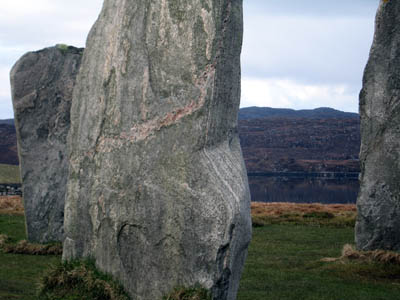 Highland Art: A Window to the West departs from conventional approaches to Scottish art. How did this publication come about?
Highland Art: A Window to the West departs from conventional approaches to Scottish art. How did this publication come about?
It was the result of the annual exhibition last year at the Royal Scottish Academy, which had a strong Highland element curated by Arthur Watson, including contemporary work such as Richard Demarco’s journey with Joseph Beuys to Rannoch Moor. Alongside this (and much else), Joanna Soden, Collections Curator at the RSA drew from the collections of the Academy some quite unexpected historical work. This show, encapsulating a time period from before the foundation of the Academy in the 1820s to the present, was our inspiration; Highland Art picks up on the energy of that exhibition but makes a slightly different selection from the Academy’s collections.
Tell me about some of the artists represented in the book and exhibition.
Some of the most intriguing works in the exhibition were Alexander Runciman’s Ossian illustrations, three of which are reproduced in the book; beautiful, experimental etchings done in the 1770s, which are rarely shown. And there’s also work from remarkable twentieth century painters who don’t get the exposure they deserve; people like James Cumming, who, instead of taking a scholarship and going to Europe, decided to go to Lewis. His paintings inspired by aspects of Highland culture such as second sight are surprisingly little known. Other work portrays the kind of romantic imagery of the Highlands that you might expect – but often with an unexpected edge.
As far as I can see the book isn’t just a ‘Window to the West’, but presents images out of the Gaelic heartland.
Yes, the G
àidhealtachd perspective is integral: that’s why the entire text is presented in both English and Gaelic. But I wouldn’t want to claim too much here.
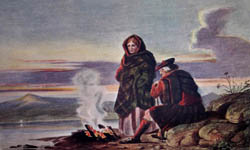 And it addresses stereotypes of the Highlanders?
And it addresses stereotypes of the Highlanders?
Well, we’re exploring the stereotype, taking another look at it from a constructively critical point of view. For instance, R.R. McIan’s mid-nineteenth century portraits of Highlanders are often seen as very much part of the stereotype, but in its totality, McIan’s work constitutes a visual anthropology of the Highlands. As Hugh Cheape, who is expert on tartan as an integral part of Highland material culture, has pointed out, McIan – a Gaelic speaker himself – deserves great credit for recording Highland dress in a period prior to photography for which there is a dearth of alternative sources.
I’m interested in what you say about cracking open stereotypes and finding examples of work that don’t refer to them.
You have to remember that any stereotype is true to some degree. The problem is that it only represents a small part of the picture. In this sense there’s nothing wrong with the stereotype, it just needs a larger context – and that’s what we’re trying to provide. It’s worth remembering that the book is itself just as part of a wider project to develop fresh approaches to Highland art, suggesting lots of ‘jumping off’ points. For example, Will Maclean’s pencil drawing Symbol Stone, which figures in the book, is one of those subtle works reflecting on Highland skills and history that immediately challenges stereotypes. And we also feature one of the great works of Arts and Crafts sculpture, Our Lady of the Isles, a statue made in the 1950s by Hew Lorimer in South Uist. 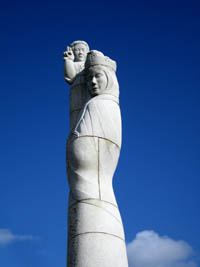 If it was perhaps anywhere other than the Western Isles, certainly if it was anywhere near London, it would be very well known. It’s a phenomenal work of art. The book is also drawing attention to artists who have dropped out of awareness. One of them, David Forrester Wilson, was well known in his day; he did a mural for Glasgow City Chambers, for example. Wilson had Islay roots and we include his oil painting of 1931, An Islay Woman, as a very interesting example of the type of social-realistic picture that was being done in the 1930s. David Forrester Wilson definitely deserves reconsideration. I Googled him just to see what would happen and kept getting Andy Warhol’s Factory – there was a David Forrester Wilson on the wall there, which was greatly liked by Warhol – quite unexpected, really.
If it was perhaps anywhere other than the Western Isles, certainly if it was anywhere near London, it would be very well known. It’s a phenomenal work of art. The book is also drawing attention to artists who have dropped out of awareness. One of them, David Forrester Wilson, was well known in his day; he did a mural for Glasgow City Chambers, for example. Wilson had Islay roots and we include his oil painting of 1931, An Islay Woman, as a very interesting example of the type of social-realistic picture that was being done in the 1930s. David Forrester Wilson definitely deserves reconsideration. I Googled him just to see what would happen and kept getting Andy Warhol’s Factory – there was a David Forrester Wilson on the wall there, which was greatly liked by Warhol – quite unexpected, really.
There are very few women represented – two women artists?
We were concentrating on the Diploma Collection of the Academy, and the lack of women is a function of the time period the book covers. For me, one of the crucial works in the book is from one of the women included, namely Frances Walker’s artists’ book, Crossing to Finlaggan. A relatively recent Academy member, Marian Leven, has done wonderful work as artist in residence at Sabhal Mòr Ostaig, but that was simply not available to us through the RSA at the time of production. There’s no doubt that in the past the Academy was a male-dominated institution, but I don’t think that’s the case anymore. There are a number of very significant women artists in it.
You refer in your introductory essay to ‘research questions at the heart of Window to the West’. I like the idea of a book with research questions at its heart. Is that what you meant when you were talking about the odd directions that can open up?
I’m more broadly involved in a research project called ‘Window to the West’ – the title derives from Sorley MacLean’s translation of his poem ‘Hallaig’ where he says ‘the window is nailed and boarded, through which I saw the west’. What he’s referring to there is Clearance, and for us the need is to re-install the window in the cleared croft. Will Maclean chose this as a strong image to base the project around, with which I thoroughly agree. Hence the mention of research questions.
You talk about the sculptural beauty of standing stones. That made me think about the black houses themselves, built like drystane dykes – and I thought, not just the way they were built but also the way that they fall down, how in both senses how they relate to nature. Because of what you said, I saw all that in sculptural terms for the first time.
One thing we’re trying to do in the project is really to think about all those issues. The more you look at vernacular architecture, the more it can be seen as a profound ecological art form. As are standing stones, in how they respond to time and landscape.
What do you mean by standing stones responding to the environment?
Well, they’re definitely astronomical markers and have a kind of cosmic relationship, but it’s also pretty obvious that a lot of them are sited not just in relation to the Moon, Sun and stars, but also actually to landscape features. We forget in the West that looking back into prehistory we have things like Chinese geomantic methods of positioning; and if you look at standing stones and stone circles, that’s what they are about. 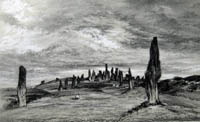 Particularly in a Highland area, you’re always seeing significant peaks with reference to standing stones. A while back I was at Foulis Wester near Crieff, checking out some standing stones there. I thought they were going to relate to one hill, Turleum, but they actually related even more strongly to Ben Vorlich. Vorlich from Foulis Wester is about fifteen miles or so. If you go on the other side of Ben Vorlich, you get a relationship to standing stones at Balquhidder. Now that’s about twenty miles between the two groups of stones, so you’re getting an amazing work of land art that, I guess, stretches over all of Scotland.
Particularly in a Highland area, you’re always seeing significant peaks with reference to standing stones. A while back I was at Foulis Wester near Crieff, checking out some standing stones there. I thought they were going to relate to one hill, Turleum, but they actually related even more strongly to Ben Vorlich. Vorlich from Foulis Wester is about fifteen miles or so. If you go on the other side of Ben Vorlich, you get a relationship to standing stones at Balquhidder. Now that’s about twenty miles between the two groups of stones, so you’re getting an amazing work of land art that, I guess, stretches over all of Scotland.
I’ve always been a happy philistine about conceptual art and installations. But I think you’ve just made me see something else quite differently: St Finnan’s Isle near Glenfinnan, where there’s an ancient bell which is supposed to be cursed if you take it away, surrounded by the chapel ruins and fallen gravestones
… it’s what you’re talking about, these stones responding to landscape – and you can see the art in the thing, imagine the island as an installation.
What you’re referring to is early Christian work, which like prehistoric work is also very responsive to landscape. It makes you just realise what a long history we have – 5,000 years or so – of being responsive to place. Awareness of that is a little knocked to the side at the moment, and it’s time to re-find it.
To be the devil’s advocate here – what is the impulse to make what we call ‘art’, why does it even matter?
Why, indeed? I would say it’s a deep ecological impulse. We are part of the planet, and there’s very little art that doesn’t really address that in one way or another, even when it seems very distanced from that. Even down to making the tiniest mark, that’s making your connection with the world. The standing stones are doing that, but so also is making someone’s portrait. Art is psychological networking, the more you engage with art, the more networks you get. These of course link art up with science and all the other ways we think.
This brings to mind Waddington’s Behind Appearance.
Yes, C.H. Waddington was a geneticist who looked at the whole history of Modernism, the period of art that tried to get away from the way everything was getting caught up in itself in Victorian drawing rooms. Paradoxically, modernists started to look at earlier ways of doing things. For example modern art practices made possible the rethinking of the artistic status of standing stones – Lucy Lippard wrote a wonderful book about this called Overlay: Contemporary Art and the Art of Prehistory. But Waddington wasn’t so much looking at the environmental side in the sense that Lippard was; as a geneticist, he was interested as a scientist, an analyst of the basic processes of nature. He saw art as a way of thinking visually about these things. He linked images of bubble chamber photographs of elementary particles with art practices. Waddington’s book was published in 1969 by Edinburgh University Press but is still one of the best places to find out how a hologram works. Interestingly he used a lot of landscape metaphors – essentially hills and glens as ways of understanding developmental processes – in his scientific work. I note in passing that the Highlands themselves play a role in the development of the cloud chamber, the precursor of the bubble chamber, which was invented by the Scot C.T.R. Wilson. Wilson won the Nobel Prize and his is the only Nobel address I know that has Ben Nevis in the first sentence – he got a lot of his ideas about cloud formation when he was working on the summit plateau of Ben Nevis at the observatory. He then used that knowledge about ionisation of clouds to create super-saturated vapours that you fire elementary particles through, to get a little track like a condensation trail. That was one of the first useful ways of tracking sub-atomic particles, so it is a very important imaging technique. The bubble chamber was a later form that was better for high energy particles – and Waddington uses photos of bubble chamber tracks in Behind Appearance, making the analogy with modern art.
Suggesting that there might be deep patterns in nature that we’re not necessarily conscious of, which emerge when we make an image?
Yes, but I think you can be a bit over-deterministic about that. It is true that there are patterns that come out in science and come out in art, but science is trying to do something rather different from art. Whereas art is really connecting you to the immediate, science is definitely involved in the area of explanation. But they do complement each other. Waddington has a wonderful analogy for that – he talks about art and science being like the Greek God Argus, who had 1,000 eyes, every single little perspective being relevant in its own right but each being interdependent with the others.
In terms of the Highlands, the Gaelic language was almost stamped out and then it has revived, raising the whole question of ownership of identity. These paintings that you’ve referred to, have you demonstrated the span between the outside view and the inside view?
That’s an interesting question. It’s also a very complicated one. It’s not a question that Highland Art specifically attempts to answer because it’s concerned with the period well after Culloden, so you’re looking at a very stressed culture and mostly artists involved would be English-speakers rather than Gaelic-speakers. 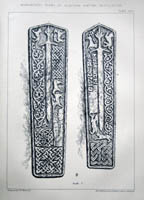 But the larger project of which the book is part does begin to address those questions. There are so many incredible parts of Gàidhealaichd art that are profoundly forgotten, at least as part of a Highland visual culture. As a historian of Scottish art, I’m used to dealing with neglected areas. People once said, ‘Scottish art, what’s that?’ but no one ever questions that now. Very often it’s simply a question of reappropriating a history. People now ask: ‘Is there a Highland art?’ What a silly question. If you think only of the Book of Kells, created by Gaelic-speakers, the answer has to be: ‘Of course there is. How could there not be?’ People tend to forget the entire West Highland school of sculpture, dating from the fourteenth to the sixteenth century. There is an amazing tradition there. There is a continuous history of Highland art, and a very interesting one, reaching back into prehistory.
But the larger project of which the book is part does begin to address those questions. There are so many incredible parts of Gàidhealaichd art that are profoundly forgotten, at least as part of a Highland visual culture. As a historian of Scottish art, I’m used to dealing with neglected areas. People once said, ‘Scottish art, what’s that?’ but no one ever questions that now. Very often it’s simply a question of reappropriating a history. People now ask: ‘Is there a Highland art?’ What a silly question. If you think only of the Book of Kells, created by Gaelic-speakers, the answer has to be: ‘Of course there is. How could there not be?’ People tend to forget the entire West Highland school of sculpture, dating from the fourteenth to the sixteenth century. There is an amazing tradition there. There is a continuous history of Highland art, and a very interesting one, reaching back into prehistory.
And that raises how each individual language affords a rather different way of looking at the world. A Gaelic-speaker once said to me, ‘Oh, I love my language. There are things I can say in Gaelic that I just can’t say in English.’ Presumably that would then feed into the perspective Gaelic-speaking artists.
Something that has intrigued me recently, is that if you have an awareness of a few Gaelic colour words, it is far easier to talk about Highland paintings in terms of these words. I’m not sure if this is a function only of Gaelic; it may be because English has become too tied into defining things. But I think language probably does make a difference, for example, to the way William McTaggart approaches his landscapes. But it may just be that if as an artist you have responded fully to the Highlands, Gaelic is be a good way of describing what you’ve done. I’m thinking of the American artist Jon Schueller who lived in Mallaig for many years. Describing his work in English would be in terms of subtle tonalities of shifting greys; in Gaelic you’d just call it ‘glas’ – or I think you would, but not being a native Gaelic-speaker I’m hesitant in saying that. But I feel drawn to the idea that there are fascinating interplays there. We don’t explore that in the book, but I hope we will elsewhere. Donald Meek, who is Professor of Scottish and Gaelic Studies at the University of Edinburgh called the book ‘A very significant milestone… a most important book, and not least in its use of Gaelic for discussion of art.’ So at the very least it’s a good starting point.
Highland Art from the Collections of the Royal Scottish Academy: A Window to the West / Ealain Ghàidhealach bho chruinneachaidhean Acadamaidh Rioghail na h-Alba: Uinneag dhan aird an Iar, Edinburgh: Royal Scottish Academy. 2008. Text in English and Gaelic. Editors: Murdo Macdonald, Joanna Soden, Lesley Lindsay, Will Maclean. ISBN 9780 905783 15 4.
Key to the images shown above, in order of appearance in the text.
Standing stones and landscape at Calanais, Lewis. Photograph by Murdo Macdonald.
Robert Ronald McIan Signal for Boat from R.R. McIan, The Highlanders at Home, or Gaelic Gatherings, 1848.
Hew Lorimer: Our Lady of the Isles, South Uist, 1957. Photograph by Murdo Macdonald.
George Harvey: ‘Great Circle of Callernish’, c.1863.
Sculptures of the West Highland School as drawn by T.P. White for his Archaeological Sketches: Kintyre, 1873.
© Jennie Renton

Comments